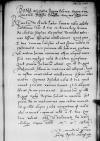Letter #2669
Bona Sforza to Ioannes DANTISCUSWielowieś, 1543-10-23
| received Heilsberg (Lidzbark Warmiński), 1543-11-03 Manuscript sources:
| ||||
Text & apparatus & commentary Plain text Text & commentary Text & apparatus Excerpts concerning Dantiscus' travels
Reverendo in Christo Patri, domino
Reverende in Christo Pater, sincere nobis dilecte.
Habuimus cf.
Quod
Quae bene valeat.
Dat(ae) or Dat(um)⌈Dat(ae)Dat(ae) or Dat(um)⌉
in
Ad mandatum proprium sacrae reginalis maiestatis


 BCz, 1601, p. 710
BCz, 1601, p. 710